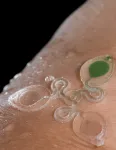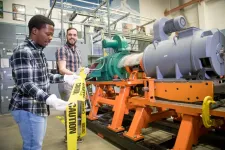(Press-News.org) Link to video and sound (details below): https://go.hawaii.edu/qRX
Sweat is more than just a sign of a good workout. It holds vital information about our health, providing clues to dehydration, fatigue, blood sugar levels and even serious conditions such as cystic fibrosis, diabetes and heart failure. Researchers at the University of Hawaiʻi at Mānoa College of Engineering have taken a giant leap forward in sweat analysis with an innovative 3D-printed wearable sweat sensor called the “sweatainer.”
Harnessing the power of additive manufacturing (3D-printing), the researchers have developed a new type of wearable sweat sensor that expands the capability of wearable sweat devices. The sweatainer is a small, wearable device similar in size to a child’s sticker that collects and analyzes sweat, offering a glimpse into the future of health monitoring. By incorporating various sensors, the sweatainer can analyze sweat in a mode similar to previous wearable sweat-sensing systems.
“3D-printing enables an entirely new design mode for wearable sweat sensors by allowing us to create fluidic networks and features with unprecedented complexity,” Department of Mechanical Engineering Assistant Professor Tyler Ray said. “With the sweatainer, we are utilizing 3D-printing to showcase the vast opportunities this approach enables for accessible, innovative and cost-effective prototyping of advanced wearable sweat devices.”
Efficient and cost-effective approach
Traditional approaches for sweat collection use absorbent pads or microbore (very narrow) tubes pressed against the epidermis (surface layer of the skin) using bands or straps to capture sweat as it emerges from the skin. These techniques require trained personnel, special handling and costly laboratory equipment. The recent emergence of wearable sweat sensors has addressed some of these challenges, but these devices still remain single-use. When the device is full, it must be removed and the sweat collection be stopped.
One unique feature of the sweatainer is its “multi-draw” sweat collection method, which allows for the collection of multiple, separate sweat samples for analysis either directly on the device or sent to a lab. Inspired by the vacutainer used in clinical blood sampling, this advancement not only makes sweat collection more efficient but also opens up new possibilities for at-home testing, storing samples for future research and integrating with existing health monitoring methods.
Field studies of the sweatainer system highlight the real-world potential of this groundbreaking technology. Through the blueprint established in the sweatainer, the researchers hope that this will continue to drive innovation to create a future where personal health monitoring is more accessible, convenient and insightful.
The findings were published in Sciences Advances on May 3.
The study was authored by Ray, and mechanical engineering students Chung-Han Wu, Howin Jian Hing Ma, Paul Baessler and Roxanne Kate Balanay.
Link to video and sound (details below): https://go.hawaii.edu/qRX
VIDEO:
BROLL (0:55):
0:00-0:15: Video of the sweatainer
0:16-0:22: Artistic rendering of the sweatainer (Credit: Ella Maru Studio)
0:23-0:26: Video of the sweatainer
0:27-0:33: Artistic rendering of the sweatainer in action (Credit: Ella Maru Studio)
0:34-0:40: Sweatainer on a person’s arm
0:41-0:47: Artistic rendering of the sweatainer in action (Credit: Ella Maru Studio)
0:48-0:55: Side by side of sweatainer on a person’s arm and artistic rendering of the sweatainer in action
SOUNDBITES:
Tyler Ray, UH Mānoa College of Engineering Assistant Professor
(0:17)
“Sweat is a really rich biofluid. It allows us to have a noninvasive window into the body to really understand a person’s physiological health state and so if we want to look at disease states like cystic fibrosis or diabetes we have access to the body in a way that would be similar to what we’d get through blood draws.”
(0:17)
“We’re really trying to think about what are the local needs here and how to address them. And so we’re doing that in partnership with JABSOM and the COBRE diabetes center, and then we’re working here in the College of Engineering to innovate and broadly build the workforce focused on healthcare innovation.”
END
Breakthrough for sweat: health monitoring device from UH researchers
2023-05-03
ELSE PRESS RELEASES FROM THIS DATE:
Studying fundamentals of water as a solvent could lead to greener cellulose-based products
2023-05-03
Water isn’t just a universal solvent that remains unaffected by its interactions. New publications from North Carolina State University show that water can change its solubility characteristics depending upon what it interacts with. Specifically, when water interacts with cellulose, it can stack in layered shells to control chemical reactions within, and physical properties of, the material. The work has implications for more sustainable and efficient design of cellulose-based products.
“Cellulose is the world’s most abundant biopolymer, and it’s used in applications ...
UC Cosmetic Science launches new program
2023-05-03
As the cosmetics industry continues to shift to more natural ingredients, some natural preservatives have been found to not be strong enough to withstand the conditions of large-scale manufacturing processes compared to chemical counterparts. One University of Cincinnati program is addressing the issue.
“The manufacturing process is optimized to work with the current system, and as a result, when they are trying to make products with these new materials, we are ending up with an increased number of cases of microbiological ...
Do your homework to prep for the 2023 and 2024 eclipses
2023-05-03
WASHINGTON, May 3, 2023 – This year and next, Americans will have the extraordinary opportunity to witness two solar eclipses as both will be visible throughout the continental U.S. On Oct. 14, 2023, the moon will obscure all but a small annulus of the sun, producing a “ring of fire” eclipse. On April 8, 2024, the eclipse will be total in a band stretching from Texas to Maine.
Both occurrences promise to be remarkable events and teachable moments. But preparation is essential.
In The Physics Teacher, co-published ...
Speedy composite manufacturing
2023-05-03
An Oak Ridge National Laboratory-developed advanced manufacturing technology, AMCM, was recently licensed by Orbital Composites and enables the rapid production of composite-based components, which could accelerate the decarbonization of vehicles, airplanes and drones.
Additive manufacturing compression molding, or AMCM, uses short-fiber-filled polymer and continuous fiber to print directly onto a mold with precise orientation to make parts such as propeller blades or battery boxes.
Compression molding then ...
Scientists find link between photosynthesis and ‘fifth state of matter’
2023-05-03
Inside a lab, scientists marvel at a strange state that forms when they cool down atoms to nearly absolute zero. Outside their window, trees gather sunlight and turn them into new leaves. The two seem unrelated—but a new study from the University of Chicago suggests that these processes aren’t so different as they might appear on the surface.
The study, published in PRX Energy on April 28, found links at the atomic level between photosynthesis and exciton condensates—a strange state of physics that allows energy to flow frictionlessly ...
Researchers detect and classify multiple objects without images
2023-05-03
WASHINGTON — Researchers have developed a new high-speed way to detect the location, size and category of multiple objects without acquiring images or requiring complex scene reconstruction. Because the new approach greatly decreases the computing power necessary for object detection, it could be useful for identifying hazards while driving.
“Our technique is based on a single-pixel detector, which enables efficient and robust multi-object detection directly from a small number of 2D measurements,” said research team leader Liheng Bian from the Beijing Institute ...
Study provides genetic evidence on new osteoporosis drug heart attack risk
2023-05-03
New research highlights potential safety concerns around women taking romosozumab, a new anti-osteoporosis drug available on the NHS. The University of Bristol-led study, published in Arthritis & Rheumatology, analysed genetic data on nearly 34,000 people.
Despite romosozumab being particularly effective at reducing the risk of fracture in women with severe osteoporosis, potential safety concerns following trial data suggest the drug may cause an increased risk of heart attack. However, subsequent research has produced conflicting results.
An international team, led by Bristol Medical School researchers, sought to investigate whether, ...
OSU research shows how hackers can target smart meters to destabilize electricity grid
2023-05-03
CORVALLIS, Ore. – A power transmission grid can be destabilized by hackers who manipulate smart meters to create an oscillation in electricity demand, researchers in the Oregon State University College of Engineering have shown.
Findings were published in IEEE Access.
The study is important because understanding where a grid’s vulnerabilities lie and what they look like is the first step in designing protection mechanisms, says associate professor of electrical engineering and computer science Eduardo Cotilla-Sanchez, who led the project with graduate student Falah Alanazi.
A ...
New catalyst transforms carbon dioxide into sustainable byproduct
2023-05-03
The need to capture CO2 and transport it for permanent storage or conversion into valued end uses is a national priority recently identified in the Bipartisan Infrastructure Law to move toward net-zero greenhouse gas emissions by 2050.
Now, Northwestern University researchers have worked with an international team of collaborators to create acetic acid out of carbon monoxide derived from captured carbon. The innovation, which uses a novel catalyst created in the lab of professor Ted Sargent, could spur new interest in carbon capture and storage.
“Carbon capture is feasible today from a technical point of view, but not yet from an economic point ...
Virtual consulting can significantly cut carbon footprint in health care, new study suggests
2023-05-03
Virtual consulting is a new and emerging contributor to environmentally sustainable health care, according to findings of new research published in the Journal of Medical Internet Research.
The COVID-19 pandemic has accelerated the shift to virtual consulting, leading to its growing use. As health systems across the world strive to achieve net-zero carbon emissions, a critical question arises: what is the impact of virtual consulting on environmental sustainability in health care? A new research study led by Sara Shaw and team aims to address this ...







